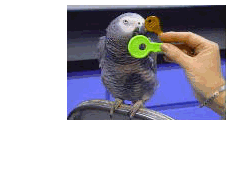| The
animal mind can be quite complex. Consider the work of Dr.
Pepperberg with her African grey parrot, Alex. Dr.
Pepperberg writes: "... During the 1940's and 1950's, European
researchers such as Koehler and Logler had shown that Grey parrots could learn
symbolic and conceptual tasks often considered as pre- or co-requisites for complex
cognitive and communicative skills." Pepperberg
has worked for many years with an African grey that she calls Alex. "Alex
has mastered tasks once thought to be beyond the capacity of all but humans or
certain nonhuman primates. Not only can he produce and comprehend English labels,
but he also understands concepts of category, "same/different",
absence, quantity, and size (my
highlighting).
"Alex has learned
over 40 object labels: paper, key, nut, wood, ...
"He
has functional use of "no", phrases such as "come here",
"I want X", and "Wanna go Y" where X and Y are appropriate
labels for objects or locations...
"He has also acquired
attribute labels. He can identify 7 colors, rose
(red), blue, green, yellow, orange, grey, and purple. He labels
5 different shapes as 2-, 3-, 4-, 5-, or 6-cornered objects. He
uses "two", "three", "four", "five", and
"sih" (six) to distinguish quantities of objects, including groups
of novel items, heterogeneous collections, and sets in which objects are randomly
arrayed. He combines attribute and object labels to identify proficiently, request,
refuse, categorize, and quantify over 100 different objects, including those that
vary from training exemplars. His accuracy averages approximately 80% on tests
of these abilities.
"Alex comprehends
a limited concept of "category". He has learned not only that "green",
for example, is one instance of the category "color", but also that,
for a particularly colored and shaped object, "green" and "3-corner"
represent two different categories of its markable attributes. Thus he
categorizes such objects with respect to either attribute based on our vocal query
of "What color?" or "What shape?" Because the same
exemplar can be the subject of shape and color queries at different times, Alex
must be able to change his basis for classification. Such ability to "reclassify"
is thought to indicate the presence of "abstract aptitude".
"Alex
has also learned abstract concepts of "same",
"different", and to respond vocally to the presence or absence
of information about these concepts. Thus when shown two identical objects or
ones that vary with respect to some or all of the attributes of color, shape,
and material, Alex responds with the appropriate category label as to which attribute
is "same" or "different" for any combination; if,
however, nothing is same or different, he replies "none". He
responds accurately to objects, colors, shapes, and materials not used in training,
including those for which he has no labels. Furthermore, he is indeed responding
to the specific questions, and not merely on the basis of his training and the
physical attributes of the objects: His accuracy was above chance levels on questions
such as "What's same?" for a green wooden triangle and a blue wooden
triangle. If he were ignoring the question and responding on the basis of his
prior training, he would have determined, and responded with the label for the
one anomalous attribute (in this case, "color"). Instead, he responded
appropriately [i.e., "shape", though "mah-mah" (matter) would
also have been correct].

"We have further data supporting his comprehension skills.
Alex was able to view different collections of 7 exemplars (each collection chosen
from among 100 objects of various combinations of shapes, colors, and materials),
be asked 1 of 4 possible vocal questions, each of which requested a different
type of information (e.g., "What color is object-X?") about a single
object in the collection, and reply vocally to each question. A correct response
indicated that he understood all the parts of the question and used these parts
to guide the search for the one object in the collection that provided the requested
information. Alex responded with an accuracy of 81.3%. We also have evidence for
comprehension of his own use of labels: If a trainer incorrectly responds to Alex's
requests (e.g., substitutes an unrequested item), he generally responds (approx.
75% of the time) by saying "No" and repeating the initial request. Finally,
a soon-to-be published manuscript demonstrates that he comprehends a relative
concept: He responds correctly to questions - asking which of two objects is the
bigger or smaller, and responds "none" if they are of equal size." One
of the striking things, watching Alex on television, is how fast he is with his
answers. When asked a question like "how many red triangles", he can
see and answer quicker than I (mind you, he's had practice). Another neat thing,
when he would make a mistake (perhaps intentionally) he would say, "Sorry". |